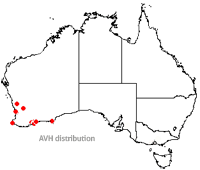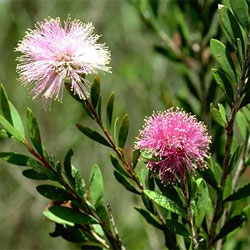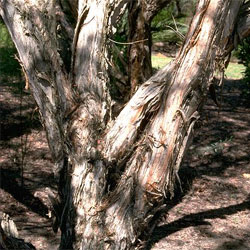Melaleuca nesophila
Showy Honey Myrtle
 Melaleuca nesophila, from the family Myrtaceae, is commonly known as the Showy Honey Myrtle. It is a medium to large shrub, grown for its dense green foliage and purple to pink pompom-like flowers that appear right through spring and summer. It is native to the southwest coast of Western Australia and is now grown in areas along the south and south east coast of Australia, in addition to Tasmania.
Melaleuca nesophila, from the family Myrtaceae, is commonly known as the Showy Honey Myrtle. It is a medium to large shrub, grown for its dense green foliage and purple to pink pompom-like flowers that appear right through spring and summer. It is native to the southwest coast of Western Australia and is now grown in areas along the south and south east coast of Australia, in addition to Tasmania.
As indicated by its coastal habitat, M. nesophila prefers well drained soils and is tolerant of drought and salty winds, but is very adaptable to different locations and conditions. It copes well with the extreme Canberra climate, even tolerating frost to a chilly -7°C. The foliage is thick and bushy when grown in full sun, but will still form a pleasing shrub in part shade.
The plant itself grows to 5m high by 4m wide and forms an excellent screen or wind break. Leaves are oblong, 1-3cm long and contain oils that are aromatic when crushed. The eye-catching flowers are a round mass of stamens with small yellow anthers, resembling mauve fireworks. These stamens are arranged in 5 clumps, and petals are reduced to small transparent scales at the base of each of these. Flowers are a bright purple when they open, fading through several shades as they age to give the appearance of multiple colours on the plant at one time. Following these are small woody seed capsules that are clustered around the stem.
Propagation is easy by tip cuttings taken in summer or by seed.However melaleucas hybridise easily and seedlings may not be true to form. This species is now becoming more popular in gardens and nurseries and is not too difficult to find. A dwarf cultivar has been released under the name of ‘Little Nessy’ and grows to approximately 2m high by 3m wide.
A worthy garden specimen, M. nesophila is low maintenance and will benefit from light trimming, mulching and a native plant fertiliser, but none of these are absolutely necessary. It is relatively free from pests and diseases, with the exception of recently Myrtle Rust, which does not affect the Australian National Botanic Gardens at this stage.
The shrub as a whole provides a habitat for insects and nesting birds, and the stunning flowers are also a food source for many of these.
Text by Shelomi Doyle (2012 Student Botanical Intern)
Name Meaning: Melaleuca nesophilaMelaleuca — derived from Greek word ‘melas’ meaning black, and ‘leucos’ meaning white, referring to the black trunk and white barked branches of some of the asian species, or possibly due to fire charring. nesophila — comes from the Greek word ‘nesos’ meaning island and ‘phileo’ meaning to love; referring to its habitat around the coast on sandy soils. |
References
Elliot, G. (2005) This ‘Little Nessy’ is no monster, Australian Horticulture, June 2005.
Newbey, K. (1972) West Australian Wildflowers for Horticulture, Part 1. Society for Growing Australian Plants, Sydney .
Paczkowska, G. & Chapman, A.R. (2000) The Western Australian Flora, A Descriptive Catalogue, Wildflower Society of Western Australia (inc), the Western Australian Herbarium, CALM & the Botanic Gardens &Parks Authority, Australia.
Sharr, F.A. (1996) Western Australian Plant Names and their Meanings, University of Western Australia Press, Nedlands WA.
Wrigley, J.W. & Fagg, M. (2007) Australian Native Plants, Concise Edition, Reed New Holland, Chatswood, Australia.
![An Australian Government Initiative [logo]](/images/austgovt_brown_90px.gif)



